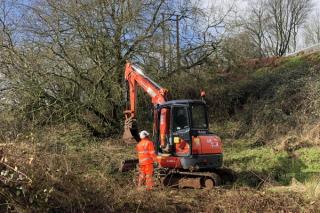
While the ground is open: multi-purpose ground investigations for developers
- Post Date
- 23 January 2023
- Read Time
- 5 minutes

The vast majority of developments will require information on the makeup and behaviour of ground deposits and how the ground is, or is not, suitable for a proposed development scheme. This is required to support planning conditions and construction design on development sites and is carried out through intrusive ground investigations.
Traditionally, different site investigation techniques have tended to operate in isolation to each other. Such investigations can be costly and could even be required for many different reasons at various stages throughout the development process. Multi-purpose ground investigations are an efficient way around this, and considering what additional information developers could get from the ground during an investigation could reap rewards.
At SLR we see a benefit to each discipline, and the Client Team, being able to assess the ground, utilising a more integrated approach, to maximise the quality of information that we recover. With over 30 different technical discipline teams at SLR, we can implement an appropriate (positive minimum) level of site investigations, across an individual site, because we are utilising a minimum number of holes for different purposes.
Why should a developer client use a multi-purpose approach?
- It’s the best way to get maximum information from below ground with the least disturbance, all whilst minimising cost/spend.
- It will utilise the same intrusive works for multiple purposes.
- Information on below ground conditions is required to support development design and discharge planning conditions.
- Having an early “heads up” about likely ground constraints will help a client manage risks throughout the development process.
- Therefore, everyone is best placed to assess and establish costs and estimates as part of a client’s budget planning.
The following information is typically required by different technical disciplines and can be obtained as part of a multipurpose ground investigation:
- Land quality consultants – extent and nature of made ground, natural ground strata, groundwater levels, samples of soil and groundwater for laboratory analysis, monitoring of groundwater and gas levels within wells.
- Geotechnical engineers - ground strength, samples for laboratory testing and groundwater levels, investigation of existing foundations.
- Archaeologists - assist with identifying different types and levels of made ground.
- Drainage engineers – potential for infiltration drainage e.g., soakaway tests.
- Ecologists – identify potential for evidence of protected terrestrial species e.g., ecologist to complete a fingertip search and flag to client.
What are the benefits for the client?
- Early discussion with specialists can support the investigation strategy e.g., type of hole, its location, depth, logging requirements and testing.
- Boreholes, window sampler holes, trial pits and trenches can be used to assess ground conditions and installation of monitoring wells can be used to assess groundwater and soil gas conditions.
- Groundwork’s contractor costs are typically over 50% of the intrusive investigation costs so it makes sense to get the most information out of each hole/intrusion.
- It allows the site to be assessed quickly, rather than waiting for each discipline to take their turns with digging ‘new holes’.
- Design options may be considered earlier in the design process with the knowledge of risks/issues raised by different disciplines.
Examples include:
- At a former wharf site on the River Lee, the archaeologists were required to complete intrusive investigations to uncover potential former wharf features, however health and safety constraints associated with trial trenching in contaminated soils restricted their investigations. Instead, they advised on locations of proposed window sampler holes being undertaken for land quality assessment purposes, observed the cores recovered, and reviewed the logs to demonstrate that no further archaeological assessment was required.
- An archaeology assessment required to support a planning condition in a marshy area enabled land quality consultants to identify the extent of made ground and advise on potential waste management options, without additional investigations and cost duplication at a later date.
- The strategic location of trial pits and boreholes, including monitoring wells, on a proposed residential development site enabled land quality sampling and assessment, soakaway testing for drainage design, and geotechnical testing for foundation design. This ensured early assumptions about site drainage and foundation design could be confirmed while completing an investigation required to obtain planning permission.
- On a residential development, site investigations in the form of window samples and small test pits were useful for archaeological purposes in assessing the levels of made ground in relation to natural. Although site investigations do not replace formal archaeological trenching, the information from the site investigations provides an indication of the levels that potential archaeology surfaces may occur. This information can be considered as part of the formal Desk Based Assessment for archaeology.
Why SLR?
With over 30 technical discipline teams at SLR, we have the required skills and experience to undertake the task. Our multi-disciplinary teams allow us to offer a whole suite of services together, as well as the flexibility to tailor a team specifically for your project.
By working collaboratively, we know more about the site at an early stage, which is highly beneficial when consulting with stakeholders. So next time you are considering conducting a ground investigation, stop and consider if you can get any additional useful information from your hole in the ground.
Recent posts
-

-

Understanding sound flanking: Fire alarm speaker cable conduits in multi-family buildings
by Neil Vyas
View post -
